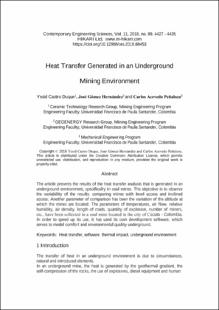| dc.contributor.author | Castro Duque, Yesid | |
| dc.contributor.author | GOMEZ HERNANDEZ, JOSE LUIS | |
| dc.contributor.author | Acevedo Peñaloza, Carlos Humberto | |
| dc.date.accessioned | 2021-11-04T15:40:58Z | |
| dc.date.available | 2021-11-04T15:40:58Z | |
| dc.date.issued | 2018-10-18 | |
| dc.identifier.uri | http://repositorio.ufps.edu.co/handle/ufps/648 | |
| dc.description.abstract | The transfer of heat in an underground environment is due to circumstances,
natural and introduced elements.
In an underground mine, the heat is generated by the geothermal gradient, the
self-compression of the rocks, the use of explosives, diesel equipment and human metabolism, etc. Since any or all of them can be heat generators, it is important to
control the temperature and humidity in the mines, both to understand the nature
of the heat sources and to calculate or estimate the magnitude of the flow of this.
(Hartman et al, 1997) [4].
The increase of the temperature in underground environments generates risks,
which can cause tragedies in the worst cases. Two main aspects must be taken
into account due to the risk generated by high temperatures: one is the affectation
to the corporal health of the workers and the other is the impact on the safety and
productivity of the mine. (Su et al, 2009) [9]. When humidity and temperatures
are high in an underground environment, workers suffer from a feeling of not
comfort, generating stress in them, and this in turn leads to an increase in
accidents and a decrease in productivity. As the depth increases and the level of
mechanization increases, the high temperatures and the damages produced by the
heating, are the biggest problems that the mining safety presents, limiting the
activity in the coal mines. (Song and Xie, 2011) [8] (Xie, Z., 2012) [11]
As a referent, in Table I, the percentage of accidents due to an increase in air
temperature is related to gold mines in South Africa. (C. Anguo.2004) [1]. | eng |
| dc.format.mimetype | application/pdf | spa |
| dc.language.iso | eng | spa |
| dc.publisher | Contemporary Engineering Sciences | spa |
| dc.relation.ispartof | Contemporary Engineering Sciences | |
| dc.rights | Copyright © 2018 Yesid Castro Duque, Jose Gomez Hernandez and Carlos Acevedo Penaloza. This article is distributed under the Creative Commons Attribution License, which permits unrestricted use, distribution, and reproduction in any medium, provided the original work is properly cited. | eng |
| dc.source | http://www.m-hikari.com/ces/ces2018/ces89-92-2018/88453.html | spa |
| dc.title | Heat transfer generated in an underground mining environment | eng |
| dc.type | Artículo de revista | spa |
| dcterms.references | C. Anguo, Formation and Harmfulness of Heat Hazard in Mine and its Control Measure, China Safety Science Journal, 8 (2004), 3-5. | spa |
| dcterms.references | Y. Castro, Y. Castro, Comfort and Environmental Quality Assurance Model for Underground Coal Mines, PhD Tesis, Project in Environmental Engineering. University of Pamplona Colombia. 2013 | spa |
| dcterms.references | Y. Castro, J. Ddelgado, J. Cáceres, Analysis of the thermal impact index generated in an underground environment, Respuestas, 19 (2014), no. 2, 32- 40. | spa |
| dcterms.references | H. Hartman, J. Mutmansky, R. Ramani, Y. Wang, Mine Ventilation and Air Conditioning, Third Edition. A Wiley-Interscience Publication.U.S.A 1997. | spa |
| dcterms.references | Ministry of Mines and Energy of Colombia, 2015. Decree 1886 of 21 September 1886. 82. | spa |
| dcterms.references | V. C. Navarro-Torres, Da Gama and R. Singh, Mathematical modelling of thermal state in underground mining, Acta Geodyn. Geomater., 5 (2008), no. 4 341–349. | spa |
| dcterms.references | V. Navarro Torres, Underground Environmental Engineering and its Applications to Portuguese and Peruan Mines, PhD Tesis, Instituto Superior Técnico de la Universidad Técnica de Lisboa. 2005. | spa |
| dcterms.references | X. Song and Z. Xie, Research on Mine Cooling Measures for Zhangshuanglou coal Mine, Procedia Engineering, 26 (2011), 1391-1397. https://doi.org/10.1016/j.proeng.2011.11.2316 | spa |
| dcterms.references | Z. Su, Z. Jiang and Z. Sun, Study on the heat hazard of deep exploitation in high-temperature mines and its evaluation index, Procedia Earth and Planetary Science, 1 (2009), no. 1, 414-419. https://doi.org/10.1016/j.proeps.2009.09.066 | spa |
| dcterms.references | S. Wang, T. Ren, T. Zhang, Y. Liang and Z. Xu, Hot environment - estimation of thermal comfort in deep underground mines, 12th Coal Operators’ Conference, University of Wollongong & the Australasian Institute of Mining and Metallurgy, (2012), 241-248 | spa |
| dcterms.references | Z. Xie, Distribution law of high temperature mine’s thermal environment parameters and study of heat damage’s causes, Procedia Engineering, 43 (2012), 588-593. https://doi.org/10.1016/j.proeng.2012.08.104 | spa |
| dc.identifier.doi | https://doi.org/10.12988/ces.2018.88453 | |
| dc.publisher.place | Bulgaria | spa |
| dc.relation.citationedition | Vol.11 No.89.(2018) | spa |
| dc.relation.citationendpage | 4435 | spa |
| dc.relation.citationissue | 89 (2018) | spa |
| dc.relation.citationstartpage | 4427 | spa |
| dc.relation.citationvolume | 11 | spa |
| dc.relation.cites | Duque, Y. C., Hernández, J. G., & Peñaloza, C. A. (2018). Heat Transfer Generated in an Underground Mining Environment. | |
| dc.relation.ispartofjournal | Contemporary Engineering Sciences | spa |
| dc.rights.accessrights | info:eu-repo/semantics/openAccess | spa |
| dc.rights.creativecommons | Atribución 4.0 Internacional (CC BY 4.0) | spa |
| dc.subject.proposal | Heat transfer | eng |
| dc.subject.proposal | software | eng |
| dc.subject.proposal | thermal impact | eng |
| dc.subject.proposal | underground environment | eng |
| dc.type.coar | http://purl.org/coar/resource_type/c_6501 | spa |
| dc.type.content | Text | spa |
| dc.type.driver | info:eu-repo/semantics/article | spa |
| dc.type.redcol | http://purl.org/redcol/resource_type/ART | spa |
| oaire.accessrights | http://purl.org/coar/access_right/c_abf2 | spa |
| oaire.version | http://purl.org/coar/version/c_970fb48d4fbd8a85 | spa |
| dc.type.version | info:eu-repo/semantics/publishedVersion | spa |










